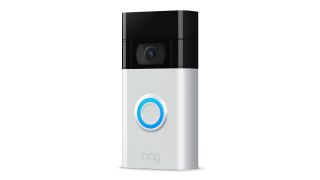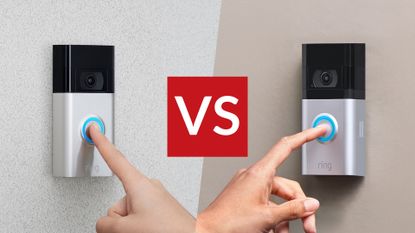If you're in the market for a camera doorbell in 2022 then, at some point, you're probably looking at the Ring Video Doorbell 4 vs Ring Video Doorbell (2nd gen) as an option.
But, as you will have seen, both look very similar but, when it comes to price, there is a marked difference, making ascertaining which is the smarter buy tricky.
Both the Ring Video Doorbell 4 and the Ring Video Doorbell (2nd gen) are among the best video doorbells at their respective prices, and offer mostly the same core features, especially when it comes to the basic functions of a smart camera doorbell. However, the more expensive model comes with some design tweaks that offer a big boost in convenience for battery-powered use, along with some extra functionality that makes it a better supplement to the best security cameras.
So will the cheaper Ring Video Doorbell (2nd gen) be enough for you, or is the Ring Video Doorbell 4 the elite camera doorbell you need? That's what this feature is designed to explore, as well as present today's very best deals on both these video doorbells.
Ring Video Doorbell 4 vs Ring Video Doorbell (2nd gen): Price & release date
The Ring Video Doorbell (2nd gen) costs £89/$99/AU$149, and was released in 2020.
The Ring Video Doorbell 4 is released in early May 2021, and costs £179/$199/AU$329. At around double the price of the cheaper model, it represents a big step up, though in the grand scheme of smart home cameras, it's a fairly typical price.
We'll cover what features both cameras bring you shortly, but we want to briefly mention the accessories you get in the box, because that potentially affects the value of the purchase. Both models come with all the basic stuff you need to mount the doorbells, including a drill bit and matching screw fittings.
However, the Ring 4 also comes with a wedge/corner kit, which are two extra little mounting plates that enable you to angle the camera's view up or down, or left and right, respectively. In our experience, these can be very useful addons, and it's hard to say whether they'll specifically benefit you until you actually test the doorbell's view.
They can be bought separately in packs of 3 matching (and stackable) mounts of each type, costing £16.99/$19.99 per pack.

The Ring Video Doorbell (2nd gen) is a plain design, which is probably best for something you just want to sit by your door.
Ring Video Doorbell 4 vs Ring Video Doorbell (2nd gen): Design & setup
These are extremely similar in looks, with just a little extra height being notable in the Ring 4, which helps it to fit in the Pre-roll feature (which we'll talk about in the next section).
The Ring Video Doorbell (2nd gen) comes with a Satin Nickel faceplate or a Venetian Bronze faceplate, while the Ring 4 comes in Satin Nickel, but you can request a free second faceplate of your choice from Ring – it just isn't in the box.
Both can be mounted without too much hassle, as long as you have a drill (or, Ring sells a separate drilling-free mounting plate if you prefer). You can actually use existing doorbell wiring to provide power to them, if you have it. If not, both are able to run off battery power alone.
Charging the battery is one of the key differences between these models. The Ring Video Doorbell (2nd gen) has to be removed from the mounting plate in its entirely when you want to charge it.
The Ring 4, however, has a removable battery pack (held in by a single security screw), so you can just pull the battery to charge. It only comes with one battery pack, but again you can buy a second, which would enable you to swap in just a second and never be without the doorbell's functionality – this is most useful if you use it as a security camera as well as a doorbell. If you're using it as a smart doorbell only, then charging the battery overnight and replacing in the morning is much less of a downside.
Setup is really easy, and is essentially identical for both devices – the Ring app makes it easy to get going, and you just follow the instructions on-screen, which will also help you to decide questions around how many of its security features you want to enable.
It's best to do all this before you do any mounting, just in case the Wi-Fi doesn't reach from your router to the doorbell well! It's much more of a pain to think about fixes after drilling than before…
If you do have this issue the simplest solution is Ring's own Chime Pro, which a) acts as a chime speaker for when people push the doorbell, and b) acts as a Wi-Fi extender for Ring devices only. Plug it between the router and the doorbell, then use the app to connect the doorbell to the Chime Pro, and it should help. Alternatively, one of the best mesh networks will probably provide enough of a wide coverage anyway.

The Ring Video Doorbell 4 offers one video major feature that the cheaper model doesn't.
Ring Video Doorbell 4 vs Ring Video Doorbell (2nd gen): Features & video quality
The Ring Video Doorbell (2nd gen) and Ring Video Doorbell 4 share the majority of really key features. That includes 1080p Full HD video, with motion detection, plus night vision. The Ring 4 has a slightly wider field of view: 160° vs 155° on the cheaper.
Both connect to Wi-Fi, and will send you a notification when someone presses the doorbell, and can optionally send you a notification whenever movement is detected. You can choose parts of the view to exclude from motion detection, and you can choose for detection to only trigger close to the doorbell, though the range for that is still fairly large.
When you get a notification, you can head into a live view of what your doorbell is seeing, and you can talk to whoever's at the door – both models have a microphone and speaker built in.
You can have the doorbells act as security cameras, recording footage whenever the button is pushed or motion is detected (you can choose exactly how it acts with quite fine-grained control). However, both models require a Ring Protect subscription to store this video in the cloud, because they don't have any on-board storage.
When it comes to video, the big difference is the Colour Pre-Roll feature on the Ring 4. This means when motion is detected or the button is pushed, you not only see what was recorded after that event, but also what came in the seconds before, thanks to a separate low-power sensor that can continuously take picture.
Both devices use the same app, which is easy to get to grips with, and gives you lots of control options – most of these are laid out in a way that makes sense, even if some are hidden away just a little. It's still among the best apps in the business. The app also enables you to access the privacy blocking features, which enables you to black out sections of the screen so that they're never recorded.
The Ring 4 has slightly better connectivity in that it supports 5GHz Wi-Fi, and both models support 2.4GHz Wi-Fi. 5GHz offers higher bandwidth but lower effective range, so it's not a vital upgrade in our eyes.
Both devices fit as part of a bigger Ring security camera ecosystem, if you decide to go that way. The same app can include more security camera feeds, and they all work together really well.
Both models are also compatible with Alexa, since Ring is an Amazon company. That means you can see who's at the door on an Echo Show device, or hear the doorbell chime on any Echo device. Lots of the best smart speakers fit the bill here.
Ring Video Doorbell 4 vs Ring Video Doorbell (2nd gen): Conclusion
If you plan to use your Ring doorbell as a security camera as much as a doorbell, then the Ring Video Doorbell 4 stands out as the better option. That's thanks to the Colour Pre-Roll feature adding more context to your videos, and the hot-swappable battery packs meaning there's no downtime if you have it running on battery power alone.
But if you're more focused on the smart doorbell side of things, the Ring 4's advantages feel much more minimal. The swappable battery pack can still be a big convenience advantage that might well sway you, but for mostly seeing who's at the door and making sure you don't miss a package, the cheaper Ring Video Doorbell (2nd gen) absolutely fits the bill.
Don't forget there's a new even cheaper wired-only Ring model – we've got a Ring Video Doorbell Wired vs Ring Video Doorbell (2nd gen) guide, if you want that comparison.











